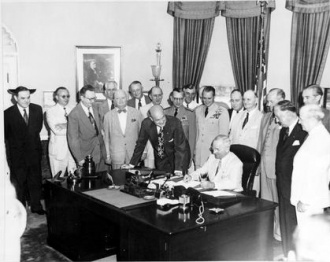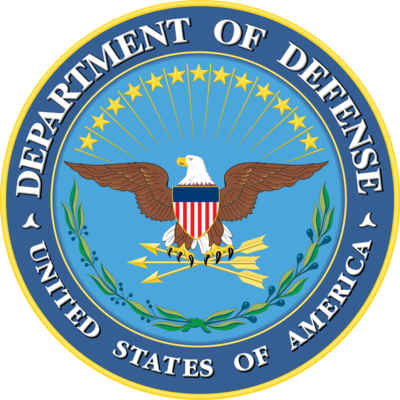Difference between revisions of "US/Department/Defense"
(sponsors Center for European Policy Analysis) |
(OSO) |
||
| Line 13: | Line 13: | ||
|logo_width=400px | |logo_width=400px | ||
|leaders=United States Secretary of Defense | |leaders=United States Secretary of Defense | ||
| − | |subgroups=U.S. Department of the Army, U.S. Department of the Navy, U.S. Department of the Air Force, Defense Intelligence Agency, National Security Agency, Defense Information Systems Agency, National Geospatial-Intelligence Agency, National Reconnaissance Office, Defense Advanced Research Projects Agency, Defense Logistics Agency, Missile Defense Agency, Defense Threat Reduction Agency, Pentagon Force Protection Agency, National Defense University, National War College, U.S. Special Operations Command, National Guard Bureau, Office of the Secretary of Defense, Joint Staff, Office of the Inspector General, Office of Net Assessment | + | |subgroups=U.S. Department of the Army, U.S. Department of the Navy, U.S. Department of the Air Force, Defense Intelligence Agency, National Security Agency, Defense Information Systems Agency, National Geospatial-Intelligence Agency, National Reconnaissance Office, Defense Advanced Research Projects Agency, Defense Logistics Agency, Missile Defense Agency, Defense Threat Reduction Agency, Pentagon Force Protection Agency, National Defense University, National War College, U.S. Special Operations Command, National Guard Bureau, Office of the Secretary of Defense, Joint Staff, Office of the Inspector General, Office of Net Assessment, Office of Special Operations |
|predecessors=U.S. Department of War, U.S. Department of the Navy | |predecessors=U.S. Department of War, U.S. Department of the Navy | ||
|website=http://www.defense.gov | |website=http://www.defense.gov | ||
| Line 21: | Line 21: | ||
The '''[[United States]] Department of Defense''' was formerly referred to as the '''US War Department'''. | The '''[[United States]] Department of Defense''' was formerly referred to as the '''US War Department'''. | ||
| − | ==Concerns== | + | == Concerns == |
| − | The department | + | The department has assisted the growth of the [[US deep state]], for example through the [[Office of Special Operations]]. It overexaggerated the military readiness of the [[USSR]] in the [[Cold War]] and has spent a steadily larger and larger fraction of the US government's income on [[weapons]], irrespective of the lack of real military threat to the USA. It cannot be understood in isolation from the [[Military-industrial-congressional complex]] spoken about by [[President Eisenhower]]. |
==History== | ==History== | ||
Revision as of 12:56, 24 May 2022
The United States Department of Defense was formerly referred to as the US War Department.
Concerns
The department has assisted the growth of the US deep state, for example through the Office of Special Operations. It overexaggerated the military readiness of the USSR in the Cold War and has spent a steadily larger and larger fraction of the US government's income on weapons, irrespective of the lack of real military threat to the USA. It cannot be understood in isolation from the Military-industrial-congressional complex spoken about by President Eisenhower.
History

The United States Congress created the War Department in 1789 and the Navy Department in 1798. The secretaries of each of these departments reported directly to the President as cabinet-level advisors.
In a special message to Congress on December 19, 1945, President Harry Truman proposed creation of a unified department of state defense, citing both wasteful military spending and inter-departmental conflicts. Deliberations in Congress went on for months focusing heavily on the role of the military in society and the threat of granting too much military power to the executive.[1]
9/11
On June 1, 2001, the DoD changed the rules for military assistance relating to aircraft hijackings, the first time since 1997, to state that for all non-immediate responses, assistance from the DoD must get personal approval from the Secretary of Defense, Donald Rumsfeld.[2]
Criticism
In 2009, the DoD faced criticism after referring to "protest" as "low-level terrorism".[3]
The DoD has faced criticism about its program of distributing surplus military equipment to US police forces. In 2014, Los Angeles Unified school police officials returned three grenade launchers to the military, although they kept the M-16 rifles and the armored vehicle.[4]
An event carried out
| Event | Location | Description |
|---|---|---|
| REX-84 | US | Scenario and drill developed by the United States federal government to detain large numbers of United States residents deemed to be "national security threats" in the event that the president declared a National Emergency (martial law). |
An example
| Page name | Description |
|---|---|
| DARPA |
References
- ↑ Hogan, Michael J. (2000). A cross of iron: Harry S. Truman and the origins of the national security state, 1945-1954. Cambridge University Press. pp. 37–38. ISBN 978-0-521-79537-1.
- ↑ http://killtown.911review.org/oddities/2001.html
- ↑ http://www.foxnews.com/story/0,2933,526972,00.html
- ↑ http://www.latimes.com/local/lanow/la-me-schools-weapons-20140917-story.html
